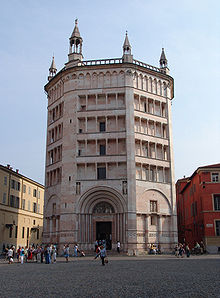Parma Cathedral
| Cattedrale di Santa Maria Assunta Cathedral of the Assumption |
|
|---|---|
 View from the east |
|
| Data | |
| place | Parma |
| builder | Benedetto Antelami |
| Construction year | after 1055; inaugurated in 1106 |
| height | 29 (tower: 63.0) m |
| Coordinates | 44 ° 48 '12 " N , 10 ° 19' 52" E |
The Cathedral of Parma with the patronage of Santa Maria Assunta ( Assumption of the Virgin Mary ) is the cathedral of the Roman Catholic Diocese of Parma .
history
An early Christian church, probably built over a pre-Christian sanctuary, had stood on the site of today's Cathedral Square since the 4th or 5th century. From 860 the Marienkirche was built nearby, which became a cathedral. After it was destroyed by fire in 1074, the construction of today's cathedral began in several construction phases. The bell tower was built between 1284 and 1294 in the Gothic style.
Architecture and equipment
The cathedral is a three-aisled basilica on a cross plan. Except for the Gothic bell tower, it shows mostly Romanesque forms. The three-storey portal facade with two horizontal and one gable-shaped arcade is remarkable . The three portals find their counterpart in the three naves of the interior.
dome
Above the crossing there is an octagonal crossing tower, which is vaulted by a dome. Inside it is painted with a landmark fresco of the Assumption of Mary by Antonio da Correggio ; his depiction uses the technique of shortening perspective adopted by Melozzo da Forlì so effectively that it is considered a model for later works of the Baroque .
Organs

The history of the cathedral's organs can be traced back to 1480 on the basis of documents. Today there are three organs in the cathedral: the main organ on the wall of the central nave, a choir organ, and a small instrument in the crypt. The main organ goes back to an instrument that the organ builders Serassi brothers rebuilt in 1786 in the then existing organ case from the 16th century. In 1999 the organ building company Mascioni was commissioned with the reconstruction of this instrument, using the remaining pipe material and the organ case. In 1942 the organ was dismantled. The instrument has 37 stops on two manuals and a pedal. The actions are mechanical.
|
|
|
|
|||||||||||||||||||||||||||||||||||||||||||||||||||||||||||||
Baptistery
The Baptistery of San Giovanni southwest of the cathedral is one of the most important of its kind. The towering, richly articulated octagon was built in 1196–1216 and then painted inside with Old and New Testament scenes.
literature
- Manfred Luchterhandt : The Cathedral of Parma. Architecture and sculpture in the age of the imperial church and the formation of communes (= Roman studies of the Bibliotheca Hertziana. Vol. 24). Hirmer, Munich 2009, ISBN 978-3-7774-7005-4 (also: Würzburg, University, dissertation, 1997).


